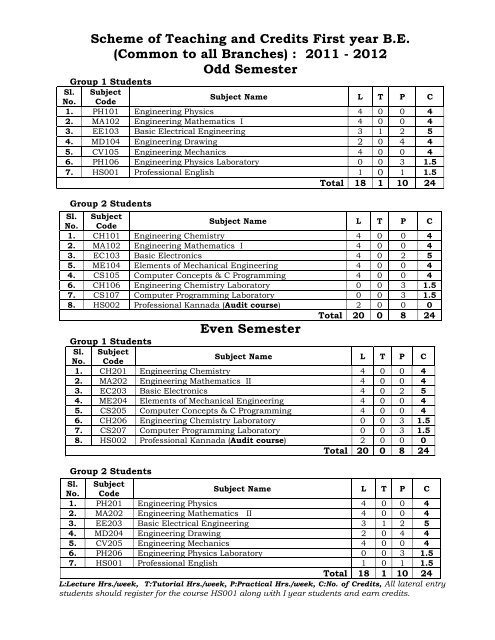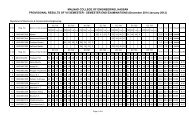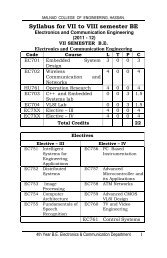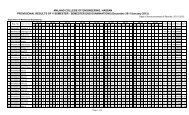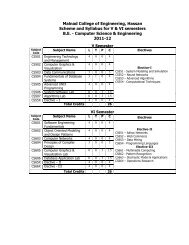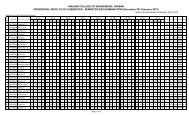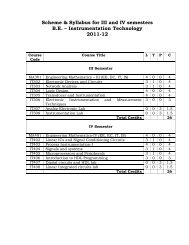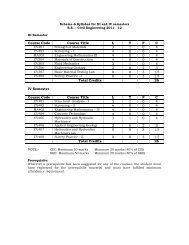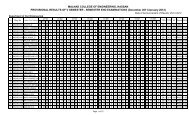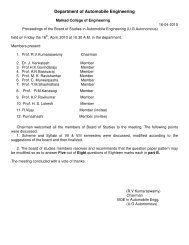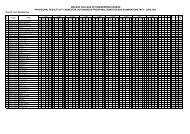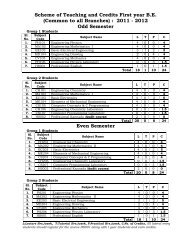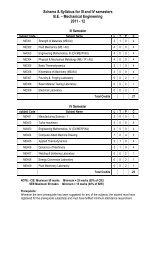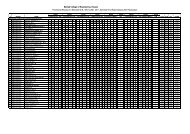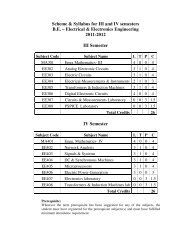Scheme of Teaching and Credits First year BE - Malnad College of ...
Scheme of Teaching and Credits First year BE - Malnad College of ...
Scheme of Teaching and Credits First year BE - Malnad College of ...
Create successful ePaper yourself
Turn your PDF publications into a flip-book with our unique Google optimized e-Paper software.
<strong>Scheme</strong> <strong>of</strong> <strong>Teaching</strong> <strong>and</strong> <strong>Credits</strong> <strong>First</strong> <strong>year</strong> B.E.<br />
(Common to all Branches) : 2011 - 2012<br />
Odd Semester<br />
Group 1 Students<br />
Sl. Subject<br />
No. Code<br />
Subject Name L T P C<br />
1. PH101 Engineering Physics 4 0 0 4<br />
2. MA102 Engineering Mathematics I 4 0 0 4<br />
3. EE103 Basic Electrical Engineering 3 1 2 5<br />
4. MD104 Engineering Drawing 2 0 4 4<br />
5. CV105 Engineering Mechanics 4 0 0 4<br />
6. PH106 Engineering Physics Laboratory 0 0 3 1.5<br />
7. HS001 Pr<strong>of</strong>essional English 1 0 1 1.5<br />
Total 18 1 10 24<br />
Group 2 Students<br />
Sl.<br />
No.<br />
Subject<br />
Code<br />
Subject Name L T P C<br />
1. CH101 Engineering Chemistry 4 0 0 4<br />
2. MA102 Engineering Mathematics I 4 0 0 4<br />
3. EC103 Basic Electronics 4 0 2 5<br />
5. ME104 Elements <strong>of</strong> Mechanical Engineering 4 0 0 4<br />
4. CS105 Computer Concepts & C Programming 4 0 0 4<br />
6. CH106 Engineering Chemistry Laboratory 0 0 3 1.5<br />
7. CS107 Computer Programming Laboratory 0 0 3 1.5<br />
8. HS002 Pr<strong>of</strong>essional Kannada (Audit course) 2 0 0 0<br />
Total 20 0 8 24<br />
Even Semester<br />
Group 1 Students<br />
Sl. Subject<br />
No. Code<br />
Subject Name L T P C<br />
1. CH201 Engineering Chemistry 4 0 0 4<br />
2. MA202 Engineering Mathematics II 4 0 0 4<br />
3. EC203 Basic Electronics 4 0 2 5<br />
4. ME204 Elements <strong>of</strong> Mechanical Engineering 4 0 0 4<br />
5. CS205 Computer Concepts & C Programming 4 0 0 4<br />
6. CH206 Engineering Chemistry Laboratory 0 0 3 1.5<br />
7. CS207 Computer Programming Laboratory 0 0 3 1.5<br />
8. HS002 Pr<strong>of</strong>essional Kannada (Audit course) 2 0 0 0<br />
Total 20 0 8 24<br />
Group 2 Students<br />
Sl. Subject<br />
No. Code<br />
Subject Name L T P C<br />
1. PH201 Engineering Physics 4 0 0 4<br />
2. MA202 Engineering Mathematics II 4 0 0 4<br />
3. EE203 Basic Electrical Engineering 3 1 2 5<br />
4. MD204 Engineering Drawing 2 0 4 4<br />
5. CV205 Engineering Mechanics 4 0 0 4<br />
6. PH206 Engineering Physics Laboratory 0 0 3 1.5<br />
7. HS001 Pr<strong>of</strong>essional English 1 0 1 1.5<br />
Total 18 1 10 24<br />
L:Lecture Hrs./week, T:Tutorial Hrs./week, P:Practical Hrs./week, C:No. <strong>of</strong> <strong>Credits</strong>, All lateral entry<br />
students should register for the course HS001 along with I <strong>year</strong> students <strong>and</strong> earn credits.
PH101/PH201 ENGINEERING PHYSICS (4-0-0) 4<br />
PART -A<br />
UNIT 1<br />
Quantum mechanics: Heisenberg's uncertainty principle <strong>and</strong> its physical<br />
significance. Application <strong>of</strong> uncertainty principle (Non-existence <strong>of</strong> electron<br />
in the nucleus). Wave function. Properties <strong>and</strong> Physical significance <strong>of</strong> a<br />
wave function. Probability density <strong>and</strong> Normalization <strong>of</strong> the wave function.<br />
Setting up <strong>of</strong> a time independent, one dimensional Schrödinger wave<br />
equation. Eigen values <strong>and</strong> eigen function. Application <strong>of</strong> Schrödinger wave<br />
equation (Energy Eigen values <strong>of</strong> a free particle, energy eigen values <strong>of</strong> a<br />
particle in a box).<br />
UNIT 2<br />
Optical Fibers: Construction <strong>of</strong> Optical fibers. Propagation mechanism in<br />
optical fibers. Angle <strong>of</strong> acceptance. Numerical aperture. Types <strong>of</strong> optical<br />
fibers <strong>and</strong> modes <strong>of</strong> propagation. Attenuation. Applications - block diagram<br />
discussion <strong>of</strong> point to point communication. Advantages <strong>and</strong> disadvantages<br />
<strong>of</strong> optical fiber communication.<br />
PART -B<br />
UNIT 3<br />
Electrical Conductivity in Metals: Free-electron concept, Classical freeelectron<br />
theory - Assumptions. Drift velocity. Mean collision time <strong>and</strong> Mean<br />
free path. Relaxation time. Expression for electrical conductivity in metals.<br />
Effect <strong>of</strong> impurity <strong>and</strong> temperature on electrical resistivity <strong>of</strong> metals. Failure<br />
<strong>of</strong> classical free-electron theory. Quantum free-electron theory -<br />
Assumptions. Fermi - Dirac Statistics. Fermi-energy - Fermi factor. Density<br />
<strong>of</strong> states -derivation <strong>of</strong> expression.<br />
UNIT 4<br />
Superconductivity: Temperature dependence <strong>of</strong> resistivity in normal <strong>and</strong><br />
superconducting metals. BCS theory (Qualitative account) Effect <strong>of</strong><br />
magnetic field (Meissner effect). Type I <strong>and</strong> Type II superconductors. High<br />
temperature superconductors. Applications <strong>of</strong> superconductors -<br />
Superconducting magnets, Maglev vehicles <strong>and</strong> SQUID. Principle.<br />
PART -C<br />
UNIT 5<br />
Dielectric Properties <strong>of</strong> Materials: Dielectric constant, polarization <strong>of</strong><br />
dielectric materials, Types <strong>of</strong> polarization, frequency response <strong>of</strong><br />
polarization. Claussius - Mussoti equation. Lorentz equation for internal<br />
fields in liquids <strong>and</strong> solids (one dimensional), Dielectric loss.<br />
UNIT 6<br />
Electricity: Basics <strong>of</strong> electricity: Circuit Elements <strong>and</strong> Sources, Electric<br />
Energy <strong>and</strong> Power, Ohm’s law, Kirch<strong>of</strong>f’s laws – Series <strong>and</strong> parallel<br />
combination <strong>of</strong> resistances, Faraday’s law, Lenz’s law, Fleming’s rule,<br />
statically <strong>and</strong> dynamically induced e. m. f, Self-inductance, mutual<br />
inductance coefficient <strong>of</strong> coupling. Calculation <strong>of</strong> self-inductance <strong>of</strong> a<br />
solenoid. Energy stored in a magnetic circuit.<br />
7 Hrs<br />
5 Hrs<br />
8Hrs<br />
5 Hrs.<br />
6Hrs<br />
7 Hrs
PART -D<br />
UNIT 7<br />
B<strong>and</strong> Theory <strong>of</strong> solids: Theory <strong>of</strong> semiconductors <strong>and</strong> semiconductor<br />
devices: energy levels – b<strong>and</strong> theory – conductors, insulators <strong>and</strong><br />
semiconductors – intrinsic <strong>and</strong> extrinsic semiconductors – PN junction –<br />
diode equation – forward <strong>and</strong> reverse bias – Zener diode –Transistor – CE,<br />
CB <strong>and</strong> CC configurations.<br />
UNIT 8<br />
Crystal Structure: Space lattice, Bravais lattice - unit cell, primitive cell.<br />
Lattice parameters. Crystal systems. Direction <strong>and</strong> planes in a crystal.<br />
Miller indices. Expression for inter-planar spacing. Co-ordination number.<br />
Atomic packing factor. X – ray diffraction by crystals, Bragg’s Law <strong>and</strong><br />
Bragg’s x-ray spectrometer.<br />
7 Hrs<br />
7 Hrs<br />
Text Books:<br />
1. R. K. Gaur <strong>and</strong> S. L. Guptha, “Engineering Physics”, 7 th Edition,<br />
Dhanpat Rai <strong>and</strong> Sons 1994.<br />
2. S. O. Pillai, “Solid State Physics”, 6 th Edition, New Age International<br />
Publisher, 2005<br />
Reference books:<br />
1. A. Beiser, “Concept <strong>of</strong> Modern Physics”, 6 th Edition, Pub. Tata Mc Graw<br />
Hill, New Delhi, 2007.<br />
2. William D Calister Jr. Pub. John, “Materials Science <strong>and</strong> Engineering an<br />
Introduction”, 4 th Edition, Willey & Sons, 1997
CH101/CH201 ENGINEERING CHEMISTRY (4-0-0) 4<br />
PART-A<br />
UNIT 1<br />
Fuels: Definition, classification <strong>and</strong> characteristics, Calorific value-<br />
Definition, gross <strong>and</strong> net calorific values (in SI units), determination <strong>of</strong><br />
calorific value <strong>of</strong> a solid fuel using Bomb calorimeter <strong>and</strong> numerical<br />
problems, Petroleum cracking-fluidized catalytic cracking; reforming <strong>of</strong><br />
petrol; Knocking- mechanism, octane number, cetane number, prevention<br />
<strong>of</strong> knocking, anti-knocking agents & Unleaded petrol, Power alcohol. 6Hrs<br />
UNIT 2<br />
High Polymers: Definition, classification, Polymerization – definition, types<br />
<strong>of</strong> polymerization, Mechanism <strong>of</strong> polymerization- free radical mechanism<br />
(ethylene as an example); Methods <strong>of</strong> polymerization, Glass transition<br />
temperature; Resins <strong>and</strong> plastics: difference between resins <strong>and</strong> plastics,<br />
Thermoplastics <strong>and</strong> thermosetting plastics – differences <strong>and</strong> examples,<br />
compounding <strong>of</strong> resins; Synthesis, properties <strong>and</strong> applications <strong>of</strong> Teflon,<br />
PMMA, polyurethane <strong>and</strong> phenol – formaldehyde resin; Elastomers -<br />
Deficiencies <strong>of</strong> natural rubber <strong>and</strong> advantages <strong>of</strong> synthetic rubber;<br />
synthesis <strong>and</strong> application <strong>of</strong> neoprene & butyl rubber; Adhesives-<br />
Manufacture <strong>and</strong> applications <strong>of</strong> epoxy resins; Conducting polymers –<br />
Definition, structure <strong>and</strong> applications <strong>of</strong> polyaniline.<br />
7 Hrs<br />
PART-B<br />
UNIT 3<br />
Water Technology: Introduction, sources <strong>of</strong> water, impurities <strong>of</strong> water,<br />
st<strong>and</strong>ards <strong>of</strong> water for industrial <strong>and</strong> municipal supplies, hardness <strong>of</strong><br />
water, boiler feed water <strong>and</strong> boiler problems, scales <strong>and</strong> sludge, External<br />
treatment <strong>of</strong> boiler feed water- lime soda process, ion exchange method.<br />
Internal treatment <strong>of</strong> water – phosphate conditioning & calgon treatment.<br />
Treatment <strong>of</strong> water for municipal purposes.<br />
7 Hrs<br />
UNIT 4<br />
Electrochemistry: Introduction, galvanic cells- construction, electrode<br />
potentials, cell notation <strong>and</strong> conventions, classification <strong>of</strong> galvanic cellsprimary,<br />
secondary <strong>and</strong> concentration cells, Single electrode potentialdefinition,<br />
origin <strong>of</strong> the electrode potential, EMF <strong>of</strong> a cell – Definition,<br />
measurement <strong>of</strong> electrode potential, Derivation <strong>of</strong> Nernst equation;<br />
St<strong>and</strong>ard electrode potential(E 0 )-definition, concentration cells- definition<br />
with examples, types <strong>of</strong> single electrode potentials, secondary reference<br />
electrodes – calomel electrode, Ag/AgCl electrode, glass electrode,<br />
determination <strong>of</strong> pH using glass electrode. Numerical problems on electrode<br />
potential, st<strong>and</strong>ard electrode potential, EMF <strong>of</strong> cell <strong>and</strong> concentration cells.<br />
7 Hrs
PART-C<br />
UNIT 5<br />
Battery technology: Batteries- definition, difference between battery <strong>and</strong><br />
cell, battery characteristics; Classification <strong>of</strong> batteries (primary <strong>and</strong><br />
secondary batteries), secondary batteries - construction, working <strong>and</strong><br />
applications <strong>of</strong> Ni- Cd & lead- acid batteries, Modern batteriesconstruction,<br />
working <strong>and</strong> applications <strong>of</strong> Zinc-air <strong>and</strong> lithium-MnO2<br />
batteries, Fuel Cells - Introduction, difference between battery <strong>and</strong> fuel<br />
cell, construction <strong>and</strong> working <strong>of</strong> H2-O2 fuel cell.<br />
6 Hrs<br />
UNIT 6<br />
Electoplating <strong>and</strong> Electroless Plating: Technological importance <strong>of</strong><br />
plating. Significance <strong>of</strong> polarization, decomposition potential <strong>and</strong> over<br />
voltage in electroplating process. Electroplating - Process, effect <strong>of</strong> plating<br />
variables on the nature <strong>of</strong> electro deposit, surface preparation <strong>and</strong><br />
electroplating <strong>of</strong> Ni <strong>and</strong> Cu. Electroless plating - Distinction between<br />
electroplating <strong>and</strong> electroless plating, advantages <strong>of</strong> electroless plating,<br />
electroless plating <strong>of</strong> copper <strong>and</strong> nickel.<br />
7 Hrs<br />
PART-D<br />
UNIT 7<br />
Corrosion Science: Corrosion- Definition, electrochemical theory <strong>of</strong><br />
corrosion; Types <strong>of</strong> corrosion-Differential metal corrosion, differential<br />
aeration corrosion (pitting <strong>and</strong> water line corrosion), Factors affecting the<br />
corrosion; Corrosion Control: protective coatings, corrosion inhibitors,<br />
cathodic <strong>and</strong> anodic protection.<br />
6 Hrs<br />
UNIT 8<br />
Environmental chemistry: Introduction to environment- Definition,<br />
Pollution- definition, types <strong>of</strong> pollution- air, water <strong>and</strong> soil, Types <strong>of</strong> air<br />
pollutants – Sources, ill effects <strong>and</strong> prevention <strong>of</strong> oxides <strong>of</strong> nitrogen,<br />
Sources, ill effects <strong>and</strong> prevention <strong>of</strong> oxides <strong>of</strong> sulphur, Sources, ill effects<br />
<strong>and</strong> prevention carbon monoxide & Sources, ill effects <strong>and</strong> prevention <strong>of</strong><br />
particulate matter, ozone depletion, acid rain <strong>and</strong> green house effect. 6 Hrs<br />
TEXT BOOKS<br />
1. Engineering Chemistry by M.M.Uppal, Khanna Publishers,Sixth<br />
Edition,2001<br />
2. A text Book <strong>of</strong> Engineering Chemistry- by Jain <strong>and</strong> Jain, Dhanapatrai<br />
Publications, New Delhi.<br />
REFERENCE BOOKS<br />
1. Principles <strong>of</strong> Physical Chemistry B.R.Puri, L.R.Sharma & M.S.Pathania,<br />
S.Nagin Ch<strong>and</strong> &Co.,33rd Ed., 1992.<br />
2. Text Book <strong>of</strong> Polymer Science by V.R.Gowarikar, N.V.Viswanathan <strong>and</strong><br />
J.Sreedhar, Wiley-Eastern Ltd.,1986.<br />
3. Environmental Chemistry by B.K.Sharma & Kaur..
MA102 ENGINEERING MATHEMATICS I (4-0-0) 4<br />
PART A<br />
UNIT 1<br />
Mean value theorems: Rolle’s Theorem (Geometrical meaning only):<br />
Lagrange’s <strong>and</strong> Cauchy’s theorems. (with pro<strong>of</strong>) Simple problems. Taylor’s<br />
<strong>and</strong> Maclaurin’s series expansions <strong>of</strong> a Function <strong>of</strong> single variable (without<br />
pro<strong>of</strong>), related problems.<br />
08 Hrs<br />
UNIT 2<br />
Polar curves: Angle between the radius vector <strong>and</strong> the tangent, pedal<br />
equations on polar curves only. Tracing <strong>of</strong> st<strong>and</strong>ard curves in cartesian,<br />
parametric polar <strong>and</strong> form.<br />
08Hrs<br />
PART B<br />
UNIT 3<br />
Partial Differentiation: Partial derivatives, total derivatives, partial<br />
derivatives <strong>of</strong> composite function, differentiation <strong>of</strong> implicit functions. 05<br />
Hrs<br />
UNIT 4<br />
Jacobeans, errors & approximations. Maxima & minima <strong>of</strong> functions <strong>of</strong> two<br />
variables. Related problems.<br />
05 Hrs<br />
PART C<br />
UNIT 5<br />
Integral Calculus And Applications: Reduction formulae, properties <strong>of</strong><br />
definite integrals, illustrative examples,<br />
05 Hrs<br />
UNIT 6<br />
Applications: To find area <strong>of</strong> a planar region, length <strong>of</strong> a plane curve,<br />
volume <strong>of</strong> solid <strong>of</strong> revolution,<br />
05 Hrs<br />
PART D<br />
UNIT 7<br />
Multiple Integrals: Evaluation <strong>of</strong> double integrals, triple integrals, change<br />
<strong>of</strong> order <strong>of</strong> integration, Illustative examples.<br />
08 Hrs<br />
UNIT 8<br />
Vector differentiation: Velocity, acceleration <strong>of</strong> a vector point function,<br />
gradient, divergence curl, Laplacian, Solenoidal & irrotational vectors &<br />
their properties illustrative examples.<br />
08 Hrs<br />
Text Book :<br />
Higher Engineering Mathematics By B S Grewal, 36th edition, Khanna<br />
publishers.<br />
Reference Books :<br />
1. Advanced Engineering Mathematics. By Erwin Kreyszig (8 th Edition)
2. Higher Engineering Mathematics. By B V Ramana Tata Megraw Hill<br />
comp. New Delhi<br />
EE103/ EE203 BASIC ELECTRICAL ENGINEERING (3-1-2) 5<br />
Theory Portions: (52 Hours)<br />
UNIT 1<br />
PART A<br />
a) Introduction: Conventional sources <strong>of</strong> energy (listing only), importance<br />
<strong>of</strong> energy, significance <strong>of</strong> electrical energy, schematic <strong>of</strong> an elementary<br />
electrical power system, definition/meaning <strong>of</strong> electrical generation,<br />
transmission <strong>and</strong> distribution systems.<br />
03 Hrs<br />
b) Measuring Instruments: Construction <strong>and</strong> principle <strong>of</strong> operation <strong>of</strong><br />
dynamometer type wattmeter <strong>and</strong> single-phase induction type energy<br />
meter, Necessity <strong>and</strong> types <strong>of</strong> earthing in electrical systems, elementary<br />
discussion on fuses. . 04 Hrs<br />
UNIT 2<br />
D. C. Circuits: Review <strong>of</strong> Ohm’s Law <strong>and</strong> its applications through<br />
illustrative examples, Kirchh<strong>of</strong>f’s laws, Maxwell’s loop equations, solution <strong>of</strong><br />
simple circuits (maximum 3 loops) exited by independent voltage sources<br />
only.<br />
06 Hrs<br />
UNIT 3<br />
PART B<br />
Single-phase A.C. Circuits: Generation <strong>of</strong> sinusoidal AC voltage, definition<br />
<strong>of</strong> average value, R.M.S. value, form factor <strong>and</strong> peak factor <strong>of</strong> sinusoidally<br />
varying voltage <strong>and</strong> current, meaning <strong>of</strong> lagging or leading <strong>of</strong> sinusoidal<br />
wave. Given a sinusoidally varying voltage or current as a function <strong>of</strong> time,<br />
obtaining its phasor representation <strong>and</strong> vice versa (by using the j-operator<br />
notation),<br />
07 Hrs<br />
UNIT 4<br />
Definition <strong>of</strong> real power, reactive power, apparent power <strong>and</strong> power factor,<br />
analysis <strong>of</strong> AC circuits with R, L, C, R-L, R-C, R-L-C parameters, illustrative<br />
examples involving series & simple parallel circuits.<br />
06 Hrs<br />
UNIT 5<br />
PART C<br />
Three Phase Circuits: Necessity <strong>and</strong> advantages <strong>of</strong> three phase systems,<br />
relationship between line <strong>and</strong> phase values for balanced star <strong>and</strong> delta<br />
connections, power in balanced three-phase circuits, power measurement<br />
by two-wattmeter method, illustrative examples.<br />
06 Hrs<br />
UNIT 6
DC Machines: Working principle <strong>of</strong> DC generator. Constructional features.<br />
E.M.F. equation. Types <strong>of</strong> D.C. generators. Working principle <strong>of</strong> DC motor,<br />
Back E.M.F. <strong>and</strong> its significance, types <strong>of</strong> motor <strong>and</strong> their application,<br />
torque equation, illustrative examples.<br />
07 Hrs<br />
UNIT 7,8<br />
PART D<br />
(a) Synchronous Generators: Principle <strong>of</strong> operation, Types <strong>and</strong><br />
constructional features, E.M.F. equation, Illustrative examples on E.M.F.<br />
equation.<br />
04 Hrs<br />
(b) Transformers: Principle <strong>of</strong> operation <strong>and</strong> construction <strong>of</strong> single phase<br />
transformers (core <strong>and</strong> shell type), E.M.F. Equation, Power losses <strong>and</strong><br />
efficiency, Illustrative examples.<br />
04 Hrs<br />
(c) Three Phase Induction Motors: Concept <strong>of</strong> rotating magnetic field,<br />
Principle <strong>of</strong> operation. Constructional features, Slip <strong>and</strong> its significance,<br />
applications, Illustrative examples on Slip calculations.<br />
05 Hrs<br />
Laboratory Portions: (15 classes <strong>of</strong> 2 Hours each, @10 hours (5 classes)<br />
per batch <strong>of</strong> students).<br />
The exact Week no. in which a given batch <strong>of</strong> students would conduct a given<br />
experiment is as per the following schedule:<br />
Batch<br />
No.:<br />
1 2 3<br />
Expt. No.:<br />
1. Week No. 01 Week No. 02 Week No. 03<br />
2. Week No. 04 Week No. 05 Week No. 06<br />
3. Week No. 07 Week No. 08 Week No. 09<br />
4. Week No. 10 Week No. 11 Week No. 12<br />
5. Week No. 13 Week No. 14 Week No. 15<br />
Laboratory Quiz: Week No.16<br />
List <strong>of</strong> Experiments to be conducted:<br />
1. Study <strong>of</strong> all types <strong>of</strong> Machines, Wall sockets, Connecting wires & other<br />
materials.<br />
2. (a) Measurement <strong>of</strong> Power <strong>and</strong> Power Factor <strong>of</strong> a Fluorescent Lamp circuit.<br />
(b) Laboratory measurement <strong>of</strong> Ground potential.<br />
3. Measurement <strong>of</strong> Energy in single phase AC circuit using an Energy meter<br />
(without any adjustments made).<br />
4. (a) Two way control <strong>of</strong> an Inc<strong>and</strong>escent Lamp<br />
(b) Running a DC Shunt Motor.<br />
5. Running a three phase Induction Motor <strong>and</strong> Speed measurements.<br />
TEXT BOOKS:<br />
1. Rajendra Prasad, Fundamentals <strong>of</strong> Electrical Engineering, Prentice-Hall<br />
<strong>of</strong> India Pvt. Ltd., 2005, ISBN: 81-203-2729-2.<br />
Reference Books:<br />
1. C.L. Wadhwa, Basic Electrical Engineering, New Age International<br />
Publishers, 2007, ISBN: 81-224-1976-3.
2. D.R. Nagpal, Fundamentals <strong>of</strong> Electrical Engineering, St<strong>and</strong>ard<br />
Publishers distributors, 2010, ISBN: 978-81-8014-147-8.<br />
3. Allan R. Hambley, Electrical Engineering- Principles <strong>and</strong> applications,<br />
third edition, PHI Learning Pvt. Ltd., 2009, ISBN: 978-81-203-3828-9.<br />
4. E. Hughes; Electrical Technology, International Students 9 th Edition,<br />
Pearson, 2005.
EC103/ EC203 BASIC ELECTRONICS (3-1-2) 5<br />
Theory Portions: (52 Hours)<br />
UNIT 1<br />
PART A<br />
Semiconductor Diodes-Introduction, p-n junction diode, characteristics,<br />
Diode approximations, Rectification, HWR, Center tapped & Bridge<br />
Rectifier, FWR, C filters (qualitative analysis) , Zener diodes, Silicon<br />
controlled rectifiers: SCR operation, SCR characteristics (19.1 exclude<br />
specification),Photo Diode & Solar cell (20.5.), problems ( Text 1). 07 Hrs<br />
UNIT 2<br />
BJT: Introduction, Transistor operation: PNP <strong>and</strong> NPN, Transistor voltage &<br />
currents amplification, Characteristics - CB, CE, CC (Both input <strong>and</strong><br />
output), Photo Transistor,(20.6. Text 1), UJT: UJT operation,<br />
characteristics, problems.( Text 1)<br />
6 Hrs<br />
UNIT 3<br />
PART B<br />
BJT Biasing – Introduction, DC load line & bias point, base bias , collector<br />
to base bias, voltage divider bias, comparison <strong>of</strong> basic bias circuits, thermal<br />
stability <strong>of</strong> bias circuits, problems.( Text 1)<br />
06Hrs<br />
UNIT 4<br />
Amplifiers & Oscillators: Classification <strong>of</strong> Amplifiers, Cascading <strong>of</strong><br />
Amplifiers, Single stage R C Coupled Transistor Amplifier, (qualitative<br />
analysis) Classification <strong>of</strong> Oscillators, Basic Principle, Feedback Oscillator<br />
Concept, Hartley <strong>and</strong> Colpitts Oscillator, Wein Bridge <strong>and</strong> RC Phase Shift<br />
Oscillator, Crystal Oscillator. Note: Only Circuit description (No<br />
Mathematical Analysis), problems.( Text 2)<br />
07Hrs<br />
UNIT 5<br />
PART C<br />
JFET & OPAMP: Introduction to FET, Working Principle, Static<br />
Characteristics <strong>of</strong> JFET, Operational Amplifier-Op-amp Characteristics, Opamp<br />
Applications Inverting <strong>and</strong> Non Inverting Amplifiers Adder, Subtractor,<br />
integrator & differentiator, problems.(Text 2)<br />
06Hrs<br />
UNIT 6<br />
Digital Logic:-Logic gates, Boolean Algebra, Demorgan’s Theorem, Logic<br />
Circuit Implementation <strong>of</strong> Boolean Expressions, half adder, full adder,<br />
parallel adder, Clocked RS ,JK,D,T flip flop, Block diagram <strong>of</strong> Micro<br />
Computer. (Text 2)<br />
07Hrs
UNIT 7<br />
PART D<br />
Communication Systems & CRO: Modulation, AM, FM, PM Modulation,<br />
Power in AM wave, Radio Transmitter, Super heterodyne Receiver,<br />
Problems, Cathode Ray Tube, waveform display, Basic oscilloscope,<br />
application <strong>of</strong> CRO, problems.( Text 2)<br />
06Hrs<br />
UNIT 8<br />
Applications: Satellite Communication principle, Cellular Telephone<br />
Networks, TV System (monochrome), Color Television, Elements <strong>of</strong> RADAR<br />
system <strong>and</strong> its Applications, Fibre optics: Introduction, Classification <strong>of</strong><br />
fibres, Advantages <strong>and</strong> Applications, Fibre optic communication system.<br />
Note; Only descriptive analysis-Block Diagram Approach (No Mathematical<br />
Analysis) ( Text 2)<br />
07Hrs<br />
Laboratory Portions:<br />
(15 classes <strong>of</strong> 2 Hours each, @10 hours (5 classes) per batch <strong>of</strong> students)<br />
The exact Week no. in which a given batch <strong>of</strong> students would conduct<br />
a given experiment is as per the following schedule:<br />
Batch No.<br />
Expt. No.<br />
1 2 3<br />
1. Week No. 01 Week No. 02 Week No. 03<br />
2. Week No. 04 Week No. 05 Week No. 06<br />
3. Week No. 07 Week No. 08 Week No. 09<br />
4. Week No. 10 Week No. 11 Week No. 12<br />
5. Week No. 13 Week No. 14 Week No. 15<br />
Laboratory Quiz: Week No.16<br />
List <strong>of</strong> Experiments to be conducted:<br />
1. Introduction to components, study <strong>of</strong> regulated power supply, Signal<br />
generator, oscilloscope, multimeter <strong>and</strong> testing <strong>of</strong> simple components. V-I<br />
characteristic <strong>of</strong> a diode.<br />
2. Half wave <strong>and</strong> full wave rectifiers using semiconductor diodes.<br />
3. FET based oscillator.<br />
4. Single stage RC coupled amplifier using transistor<br />
5. Op-Amp:inverting & non-inverting amplifier<br />
TEXT BOOKS:<br />
1. David A Bell, “Electronic Devices <strong>and</strong> Circuits”, PHI, India, 4 th edition.<br />
2. D Chattopadhyay <strong>and</strong> P C Rakshit, ”Electronics Fundamentals <strong>and</strong><br />
Applications” New Age International (P) Limited, India, 10 th edition<br />
REFERENCE BOOKS:<br />
1. Ramakant .A. Gayakwad “OP-AMPS & Linear Integrated circuits”, PHI,<br />
New Delhi, 3rd edition, 2004<br />
2. Morris Mano “Digital Logic <strong>and</strong> Computer Design”, PHI, EEE 3 rd Edition<br />
2004<br />
3. Nagabhushan <strong>and</strong> Murthi Mahadeva Naik G, “Basic Electronics” Star<br />
tech publication 2010
ME104/ME204 ELEMENTS OF MECHANICAL ENGINEERING (4-0-0)4<br />
UNIT 1<br />
PART A<br />
Sources <strong>of</strong> Energy: Introduction <strong>and</strong> classification <strong>of</strong> Sources <strong>of</strong> Energy,<br />
Merits <strong>and</strong> demerits, Applications with Examples<br />
03 Hrs<br />
Boilers: Formation <strong>of</strong> steam with constant pressure, Introduction,<br />
classification <strong>of</strong> Boilers, Basic principles <strong>of</strong> Water tube <strong>and</strong> Fire tube<br />
Boilers, List <strong>and</strong> Functions <strong>of</strong> Boiler Mountings <strong>and</strong> Accessories.[No<br />
Figures]<br />
03 Hrs<br />
UNIT 2<br />
Prime Movers: Classification <strong>of</strong> Prime movers, Principles <strong>of</strong> operation <strong>of</strong><br />
Steam Turbines Impulse& Reaction Turbine (With P-V Diagram), Gas<br />
Turbine (Open & Closed cycle)Water Turbines (Pelton Wheel, Francis,<br />
Kaplan Turbine).I C. Engines-Otto &Diesel cycle, Two & Four stroke Petrol<br />
<strong>and</strong> Diesel Engines.<br />
08 Hrs<br />
PART B<br />
UNIT 3<br />
Power Transmission: Belt Drive-Open& Crossed Belt drive, Expression for<br />
velocity ratio-Gear drives-Classification <strong>and</strong> Nomenclature <strong>of</strong> spur Gear.<br />
Simple sketches <strong>of</strong> Helical, Bevel <strong>and</strong> Worm gear drives, Simple <strong>and</strong><br />
compound gear Drives, velocity ratio (No Numerical problems) Applications.<br />
03 Hrs<br />
Lubrication & Bearings: Purpose <strong>of</strong> lubrication, Types <strong>and</strong> properties <strong>of</strong><br />
lubricants, Drop Feed <strong>and</strong> Splash lubrication, Introduction to Bush <strong>and</strong><br />
Anti friction Bearings<br />
05 Hrs<br />
UNIT 4<br />
Refrigeration And Air conditioning: Unit <strong>of</strong> Refrigeration, Coefficient <strong>of</strong><br />
performance, Refrigerants, Types& Properties <strong>of</strong> Refrigerants, Different<br />
parts <strong>of</strong> Refrigerator, Vapour compression refrigeration, Vapour absorption<br />
refrigeration ,Introduction to Air-conditioning- Window type air conditioner.<br />
07 Hrs<br />
PART C<br />
UNIT 5<br />
Manufacturing Process: Introduction <strong>and</strong> classification <strong>of</strong> manufacturing<br />
processes. Casting-Principles <strong>of</strong> S<strong>and</strong> casting, Permanent Mould casting,<br />
Hot <strong>and</strong> cold camber Die- casting processes, Advantages, Limitation <strong>and</strong><br />
Applications. Plastic processing: Compression Moulding <strong>and</strong> Injection<br />
Moulding <strong>of</strong> plastics.<br />
06 Hrs<br />
UNIT 6<br />
Metal Forming: Principles <strong>of</strong> Rolling, Forging, Extrusion (Direct & Indirect<br />
Extrusion) Wire Drawing. Typical examples <strong>of</strong> components produced in<br />
these processes, advantages <strong>and</strong> Limitations & Application.
Joining process: Brief description <strong>of</strong> Electric Arc Welding, Gas Welding,<br />
Brazing <strong>and</strong> Soldering.<br />
06 Hrs<br />
PART D<br />
UNIT 7<br />
Conventional Machining: Introduction to Lathe, Block Diagram <strong>of</strong> lathe,<br />
Nomenclature <strong>of</strong> single point cutting tool, Sketches depicting operations <strong>of</strong><br />
Turning, Taper turning, <strong>and</strong> Thread cutting. Introduction to Drilling<br />
machine & operation, Milling Machine & operations. Abrasive Machining:<br />
Common abrasives, cylindrical <strong>and</strong> centre less grinding operation,<br />
Advantages <strong>and</strong> limitations.<br />
07 Hrs<br />
UNIT 8<br />
Non conventional Machining: Introduction, Principles, advantages,<br />
limitations <strong>and</strong> applications <strong>of</strong> AJM, EDM, LBM processes. 04 Hrs<br />
Text Books:<br />
1. Roy S.K.H.Choudry.A.K.H.Choudry, Elements <strong>of</strong> mechanical Engineering<br />
5 th Edition,1997, Media Prometers <strong>and</strong> publishers, Mumbai.<br />
2. S.K.H.Choudry, A.K.H,Choudry, Nirjhar Roy Elements <strong>of</strong> work shop<br />
Technology, Vol 1&2 11 th Edition, 2001, Media promoters <strong>and</strong><br />
publishers Mumbai<br />
Reference Books:<br />
1. K.R.Gopal Krishna “A Text Book <strong>of</strong> Mechanical Engineering Sciences”15 th<br />
Edition 1999, Subhas Publishers, Bangalore<br />
2. Raguhwansi “A course in work shop vol I ” Dhanpat Rai & Sons, New<br />
Delhi.
MD104/MD204 ENGINEERING DRAWING (2-0-4) 4<br />
PART A<br />
Introduction: BIS conventions for drawing sheets, Lettering for pencil<br />
Drawing, Line styles, Material conventions.<br />
Curves used in Engineering: Conic section – Ellipse, Parabola, Hyperbola<br />
Basic method <strong>of</strong> construction. Concentric Circle method, Rectangle method.<br />
Cycloidal curves: Cycloid, Epicycloids, Hypocycloid <strong>and</strong> Involutes. 08 Hrs<br />
Orthographic Projections: Orthographic projection-planes <strong>of</strong> projection,<br />
Four quadrants, projection <strong>of</strong> points, points in different quadrants.08 Hrs<br />
Projection <strong>of</strong> straight lines: <strong>First</strong> angle Projection only Parallel to one or<br />
both planes-contained by one or both planes –Perpendicular to a plane-<br />
Inclined to one plane, Parallel to the other-Inclined to both planescontained<br />
by a plane perpendicular to both planes-True length <strong>of</strong> a line <strong>and</strong><br />
its inclination with the reference plane. (No practical problems) 09 Hrs<br />
Projection <strong>of</strong> Planes: Types <strong>of</strong> planes-Perpendicular planes-Oblique<br />
planes- Projection <strong>of</strong> planes, Parallel to one plane-Perpendicular to both<br />
planes-Perpendicular to one inclined to the other-oblique planes.<br />
07 Hrs<br />
PART B<br />
Projection <strong>of</strong> solids: Using change <strong>of</strong> position method <strong>and</strong> Auxiliary plane<br />
method, polyhedrons-Solids <strong>of</strong> revolution-solids in simple position-Axis<br />
perpendicular to a plane-Axis parallel to one plane <strong>and</strong> inclined to the<br />
other-Axis inclined to both planes (excluding combination <strong>of</strong> solids). 10 Hrs<br />
Development <strong>of</strong> surfaces: Development <strong>of</strong> surfaces <strong>of</strong> cubes-Prisms<br />
cylinders- pyramids-cones. Parallel line method. Radial line method. With<br />
sections. (No Transition pieces, No combination.)<br />
09 Hrs<br />
Pictorial views: Introduction to perspective projection, Isometric axes, lines<br />
<strong>and</strong> planes-Isometric projection. Simple combination allowed Simple<br />
Machine parts<br />
06 Hrs<br />
Text Books:<br />
1. Engineering Drawing: N.D.Bhat <strong>and</strong> M.Panchal, 37 th Edition<br />
1996,charotar publishing House.Gujarat<br />
2. Engineering Drawing: K.R. Gopal Krishna , 24 th Edition 1999 Subhash<br />
publications, Bangalore.<br />
SCHEME FOR QUESTION PAPER
Part<br />
A<br />
Part<br />
B<br />
Q1: Conic section - 10 Marks Q2: Points - 05 Marks<br />
Other Curves - 10 Marks Lines - 15 Marks<br />
Q3: Lines - 20 Marks Q4: Planes - 20 Marks<br />
Q5: Solids change <strong>of</strong> position Q6: Solids-Auxiliary plane<br />
Method - 20 Marks<br />
Methods - 20 Marks<br />
Q7: Development <strong>of</strong> Surfaces Q8: Isometric projections -<br />
- 20 Marks<br />
20 Marks<br />
Note: Students have to answer any FIVE full questions selecting TWO full<br />
questions from each part.
CV105/CV205 ENGINEERING MECHANICS (4-0-0) 4<br />
PART – A<br />
UNIT 1<br />
Introduction: Definition <strong>of</strong> a force ― Basic idealizations <strong>of</strong> mechanics like<br />
particle, continuum, rigid body ― Basic principles <strong>of</strong> Mechanics ― systems<br />
<strong>of</strong> forces ― Units <strong>of</strong> measurements<br />
05 Hrs.<br />
UNIT 2<br />
Coplanar Concurrent Force System: Coplanar forces - Coplanar<br />
concurrent force ― Resolution <strong>and</strong> composition <strong>of</strong> forces. Static Equilibrium<br />
<strong>of</strong> coplanar concurrent force systems.<br />
06 Hrs.<br />
UNIT 3<br />
PART – B<br />
Coplanar Non Concurrent Force System : Moment <strong>of</strong> a force-couple–<br />
Varignon’s Theorem Composition <strong>of</strong> coplanar non-concurrent Force<br />
Systems<br />
05 Hrs.<br />
UNIT 4<br />
Coplanar Non Concurrent Force System (Contd..) Static equilibrium <strong>of</strong><br />
coplanar non-concurrent Force Systems. Different types <strong>of</strong> supports.<br />
Introduction to statically determinate <strong>and</strong> indeterminate beams.<br />
Determination <strong>of</strong> support reactions for statically determinate beams<br />
subjected to various types <strong>of</strong> loads.<br />
05 Hrs.<br />
UNIT 5<br />
PART – C<br />
Centroid <strong>and</strong> Centre <strong>of</strong> Gravity : Determination <strong>of</strong> the position <strong>of</strong> centroid<br />
<strong>of</strong> a plane figures by integration― Determination <strong>of</strong> the position <strong>of</strong> centroid<br />
<strong>of</strong> plane figures <strong>and</strong> built-up sections by the method <strong>of</strong> moments.<br />
06 Hrs.<br />
UNIT 6<br />
Second Moment <strong>of</strong> Areas : Second moment <strong>of</strong> an area, product <strong>of</strong> Inertia,<br />
principal moments <strong>of</strong> inertia (concepts), Radius <strong>of</strong> gyration parallel axes<br />
<strong>and</strong> perpendicular axes theorems ― Determination <strong>of</strong> moment <strong>of</strong> inertia <strong>of</strong><br />
plane figures, composite areas <strong>and</strong> built-up sections.<br />
07 Hrs.<br />
PART – D<br />
UNIT 7<br />
Friction: Types <strong>of</strong> friction, laws <strong>of</strong> static friction. Static equilibrium <strong>of</strong><br />
coplanar force systems involving friction: wedges, ladders, belt drives etc.<br />
09 Hrs
UNIT 8<br />
Introduction to Dynamics: Basic definitions ― types <strong>of</strong> motion, kinematics<br />
<strong>of</strong> a particle ― projectiles― Definitions ― Range ― Time <strong>of</strong> flight. Equation<br />
for the path <strong>of</strong> a projectile ― Range on an inclined plane<br />
Newton’s Laws <strong>of</strong> motion ― D’Alembert’s Principle <strong>and</strong> its applications ―<br />
Kinetics <strong>of</strong> motion along a circular curve-super elevation. Work, power <strong>and</strong><br />
energy.<br />
09 Hrs<br />
Text Books<br />
1. Beer <strong>and</strong> Johnston, Vector Mechanics for Engineers Statics <strong>and</strong><br />
Dynamics” (In SI Units) 8 th Edition - 2007 – Mc.Graw Hill<br />
Publications.<br />
2. Ramamrutham S: “Text book <strong>of</strong> Applied Mechanics”, Dhanpat Rai<br />
<strong>and</strong> Sons, India. 1997<br />
Reference Books<br />
1. Rajashekaran S, <strong>and</strong> Sankar Subramanian, G., “ Engineering<br />
Mechanics – Statics <strong>and</strong> Dynamics”.<br />
2. Timoshenko <strong>and</strong> Young, “Engineering Mechanics” TMH publishing,<br />
India. Statics <strong>and</strong> Dynamics”. 2006<br />
3. S.S.Bhavikatti ‘ Engineer Mechanics’ , New Age International, 3 rd<br />
Edition.
CS105/CS205 COMPUTER CONCEPTS AND C PROGRAMMING (4-0-0) 4<br />
PART A<br />
UNIT 1<br />
Introduction to Computer Systems, Interacting with the Computer,<br />
Computer Organization<br />
Definition <strong>of</strong> computers, Early days <strong>of</strong> computer, basic parts <strong>of</strong> a computer,<br />
basic structure <strong>of</strong> computer, categorizing computers, Information<br />
processing life cycle, Essential computer hardware, Essential computer<br />
s<strong>of</strong>tware, Exploring keyboard, working <strong>of</strong> the keyboard, exploring a mouse,<br />
using a mouse, types <strong>of</strong> mouse devices, working with mouse, inputting<br />
data in other ways, commonly used video <strong>and</strong> sound output devices,<br />
describing monitor characteristics, exploring printer, Exploring printer<br />
characteristics, types <strong>of</strong> printers. Decimal number system, binary number<br />
system, ASCII, BCD, CPU, how does CPU works.<br />
7 Hrs<br />
UNIT 2<br />
Storage Device Concepts, Operating Systems, Networking<br />
Storage media, floppy drive, hard disks, optical media, CD-ROM, CD-R, CD-<br />
RW, DVD-ROM, Recordable DVD, About s<strong>of</strong>tware, Custom made s<strong>of</strong>tware,<br />
Pre-written s<strong>of</strong>tware, Types <strong>of</strong> operating system, Computer processing<br />
techniques, Functions <strong>of</strong> operating system, Convergence <strong>of</strong> computing with<br />
communications, Network Basics, Need for Networking, Basic components<br />
<strong>of</strong> a network, Exploring the types <strong>of</strong> Networks.<br />
7 Hrs<br />
PART B<br />
UNIT 3<br />
Overview <strong>of</strong> C: History <strong>of</strong> C, Importance <strong>of</strong> C, Basic structure <strong>of</strong> C<br />
program, executing a C program.<br />
Constants, Variables, <strong>and</strong> Data types: Characters set, C tokens,<br />
Keywords <strong>and</strong> Identifiers, Constants, Variables, Data types, Declaration <strong>of</strong><br />
variables.<br />
Operators <strong>and</strong> Expressions : Arithmetic operators, Relational operators,<br />
Logical operators, Assignment operators, Increment <strong>and</strong> Decrement<br />
operators, Conditional operator, Bit wise operators, Special operators,<br />
Arithmetic expressions, Evaluation <strong>of</strong> expressions. Precedence <strong>of</strong> Arithmetic<br />
operators, Type conversions in expressions, Operator precedence <strong>and</strong><br />
associatively.<br />
7 Hrs<br />
UNIT 4<br />
Managing Input <strong>and</strong> Output Operations: Reading a character, writing a<br />
character, Formatted Input, Formatted Output<br />
Decision making <strong>and</strong> Branching: Decision making with if statement,<br />
Simple if statement, The if…else statement, Nesting <strong>of</strong> if…else statements,<br />
The else … if ladder, The switch statement, The : operator, The Go to<br />
statement<br />
7 Hrs
PART C<br />
UNIT 5<br />
Decision making <strong>and</strong> Looping: The while statement, The do statement,<br />
The for statement, Jumps in Loops.<br />
Arrays: One-dimensional Arrays, Declaration <strong>of</strong> one-dimensional Arrays,<br />
Initialization <strong>of</strong> one-dimensional Arrays<br />
6 Hrs<br />
UNIT 6<br />
Arrays: Two-dimensional Arrays, Initializing two-dimensional Arrays.<br />
Character Array <strong>and</strong> Strings: Declaring <strong>and</strong> initializing string variables,<br />
reading strings from terminal, writing strings to screen, arithmetic<br />
operation on characters, putting strings together, comparison strings,<br />
string h<strong>and</strong>ling functions.<br />
6 Hrs<br />
PART D<br />
UNIT 7<br />
User-defined Functions : Need for User-defined Functions, A multifunction<br />
Program, Elements <strong>of</strong> User-defined Functions, Definition <strong>of</strong><br />
Functions, Return Values <strong>and</strong> their Types, Function Calls, Function<br />
Declaration, Category <strong>of</strong> Functions, No Arguments <strong>and</strong> no Return Values,<br />
Arguments but no Return Values, Arguments with Return Values, No<br />
Argument but Returns a Value, Functions that Return Multiple Values.<br />
6 Hrs<br />
UNIT 8<br />
Basic Concepts <strong>of</strong> Parallel Programming: Motivating parallelism, Scope<br />
for parallel computing, Thread basics, Why threads OpenMP: A st<strong>and</strong>ard<br />
for directive – based parallel programming, The OpenMP programming<br />
model, Specifying concurrent tasks in OpenMP, Synchronization constructs<br />
in OpenMP, Data h<strong>and</strong>ling in OpenMP, OpenMP library functions,<br />
Environment variables in OpenMP.<br />
6 Hrs<br />
Text Books:<br />
1. Vikas Gupta: Computer Concepts <strong>and</strong> C Programming, Dreamtech<br />
Press/Wiley India, 2009. (Chapters: 1.1, 1.2, 1.4 –1.9, 2.1, 2.5, 2.7 –<br />
2.10, 2.14 – 2.16, 2.19 – 2.21, 3.1-3.4, 3.6, 3.7, 4.1 – 4.3, 4.6 – 4.11, 5.1<br />
– 5.6, 6.1, 6.3 – 6.6)<br />
2. E. Balagurusamy: Programming in ANSI C, 5 th Edition, TataMcGraw Hill,<br />
2010. (Chapters: 1.1, 1.2, 1.8, 1.10, 2.2-2.8, 3.2-3.15, 4.2-4.5, 5.2-5.9,<br />
6.2-6.5, 7.2-7.6, 8.2-8.8, 9.2-9.14)<br />
3. Ananth Grama, Anshul Gupta, George Karypis, Vipin Kumar:<br />
Introduction to Parallel Computing, 2 nd Edition, Pearson<br />
Education, 2003. (Chapters: 1.1, 1.2, 7.1, 7.2 <strong>and</strong> 7.10(except: 7.10.7))<br />
Reference Books:<br />
1.Behrouz A. Forouzan, Richard F. Gilberg: Computer Science – A Structured<br />
Approach Using C, 3 rd Edition, Cengage Learning, 2007.<br />
2. Brian W. Kernighan <strong>and</strong> Dennis Ritchie: The C Programming Language, 2 nd<br />
Edition, PHI, 1998.<br />
3. Programming Techniques through C, M. G. V.Murthy, Pearson Education, 2002<br />
Web Reference: http://elearning.vtu.ac.in
HS001 PROFESSIONAL ENGLISH (1-0-1)1.5<br />
The course is designed for 26 hours in a semester. This course is<br />
structured for 13 sessions <strong>of</strong> 2hours each <strong>and</strong> will be conducted in the<br />
following components:<br />
Session No.<br />
Topics (Each session is for 2 hours)<br />
Session 1 • Introduction – Self/others;<br />
• Expectations<br />
• Golden Rules<br />
Session 2<br />
Basics <strong>of</strong> Communication<br />
• Listening<br />
• Speaking<br />
• Body Language<br />
• Written Communication<br />
Session 3<br />
Importance <strong>of</strong> English Language<br />
Grammar – Parts <strong>of</strong> Speech<br />
Session 4<br />
Art <strong>of</strong> Small talk<br />
Grammar – Punctuations<br />
Session 5 Listening – Heart <strong>of</strong> Communication<br />
General<br />
Academics<br />
Grammar – Sentence Structure<br />
Session 6<br />
Nouns, Articles <strong>and</strong> Quantifiers<br />
Functions <strong>of</strong> Adjectives & Adverbs<br />
Session 7<br />
Verbs <strong>and</strong> Tenses<br />
Subject verb agreement<br />
Session 8<br />
Session 9<br />
Speaking Skills - Practice<br />
Prepositions<br />
Reading Exercises – General<br />
Academic<br />
Vocabulary Building<br />
Session 10 Writing Skills – General<br />
Academic<br />
Vocabulary Building<br />
Session 11<br />
Reported Speech<br />
Vocabulary Building<br />
Session 12 Study Skills – Graphic Organizers<br />
Memory Techniques<br />
Session 13 Study Skills – Mind mapping<br />
Note taking<br />
Feedback
PH106/PH206 ENGINEERING PHYSICS LAB (0-0-3) 1.5<br />
(Any Ten Experiments are to be conducted)<br />
1. Verification <strong>of</strong> Kirch<strong>of</strong>f’s law, Ohm’s law, series <strong>and</strong> parallel resistances.<br />
2. Characteristics <strong>of</strong> semiconductor diode, Zener diode.<br />
3. Characteristics <strong>of</strong> a Transistor.<br />
4. Dielectric Constant (Measurement <strong>of</strong> dielectric Constant).<br />
5. Magnetic properties (B-H Graph method).<br />
6. Planck's Constant (Determination <strong>of</strong> Planck's constant using LED or<br />
using the principle <strong>of</strong> photoelectric effect).<br />
7. Electrical resistivity (Four probe method).<br />
8. Verification <strong>of</strong> Stefan's law.<br />
9. Determination <strong>of</strong> Fermi energy.<br />
10. Single cantilever: To estimate the Young’s modulus <strong>of</strong> the given<br />
material.<br />
11. Diffraction grating: To determine the wave length <strong>of</strong> the Hg spectrum<br />
using spectrometer.<br />
12. Newton’s rings: To measure the wavelength <strong>of</strong> the monochromatic<br />
source by forming Newton’s rings.<br />
13. Sonometer: To calculate the frequency <strong>of</strong> AC supplies using Sonometer.
CH106/CH206 CHEMISTRY LAB (0-0-3) 1.5<br />
List <strong>of</strong> experiments:<br />
PART A<br />
1. Estimation <strong>of</strong> Mohr’s salt using KMnO4 solution <strong>and</strong> oxalic acid crystals.<br />
2. Determination <strong>of</strong> Total hardness <strong>of</strong> a given sample <strong>of</strong> water using<br />
disodium salt <strong>of</strong> EDTA.<br />
3. Determination <strong>of</strong> Calcium oxide in the given sample <strong>of</strong> cement by rapid<br />
EDTA method.<br />
4. Determination <strong>of</strong> iron in the given sample <strong>of</strong> haematite ore solution<br />
using potassium dichromate crystals by external indicator method.<br />
5. Determination <strong>of</strong> percentage <strong>of</strong> Copper in brass using st<strong>and</strong>ard sodium<br />
thiosulphate.<br />
6. Determination <strong>of</strong> COD <strong>of</strong> the given industrial waste water sample.<br />
PART B<br />
1. Determination <strong>of</strong> P ka value <strong>of</strong> weak acid using pH meter.<br />
2. Potentiometric estimation <strong>of</strong> FAS using K2Cr2O7.<br />
3. Colorimetric estimation <strong>of</strong> copper.<br />
4. Conductometric estimation <strong>of</strong> acid using st<strong>and</strong>ard NaOH.<br />
5. Conductometric estimation <strong>of</strong> acid mixture using st<strong>and</strong>ard NaOH.<br />
6. Determination <strong>of</strong> viscosity coefficient <strong>of</strong> a given liquid using Ostwald’s<br />
Viscometer.<br />
Reference Books:<br />
1. Vogels text book <strong>of</strong> quantitative inorganic analysis, revised by J. Bassett,<br />
R.C. Denny, G.H.Jeffery, 4th Ed.<br />
2. Practical Engineering chemistry by Sunitha <strong>and</strong> Rathna.
CS107/CS207 COMPUTER PROGRAMMING LAB (0-0-3) 1.5<br />
PART A<br />
Demonstration class on internal components (hardware) <strong>of</strong> a computer.<br />
Students will be trained to:<br />
To create a C source program using different editors, to include <strong>and</strong><br />
remove documentation, to compile a C source program, to link a C<br />
source program with functions needed from the C library, to name<br />
the variables appropriately, to execute C programs using comm<strong>and</strong><br />
line turbo C compiler <strong>and</strong> linker using IDE, to debug the C source<br />
programs, to use single step execution, to create <strong>and</strong> run C source<br />
programs with/without inputs, to create/delete/rename folders, to<br />
create/delete/search/rename/execute files in specified folder, to<br />
create shortcut for turbo C on the desktop.<br />
PART B<br />
1. Exercise on writing simple C Programs (like find the sum <strong>of</strong> two<br />
numbers using formatted I/O, different bases like hexa <strong>and</strong> octal <strong>and</strong><br />
different types like int, long, longint etc.,).<br />
2. Exercise on writing simple C programs using if else statements (like Find<br />
biggest <strong>of</strong> three numbers).<br />
3. Exercise on writing simple C programs using switch statement (like<br />
Provide multiple operations, addition, subtraction, etc.).<br />
4. Exercises on writing C programs using loop structures (like Find the<br />
sum <strong>of</strong> first ‘N’ natural numbers).<br />
5. Exercise on writing C programs using functions (like Generate <strong>and</strong> print<br />
first n Fibonacci numbers).<br />
6. Exercise on writing C programs using recursive function (like Find the<br />
factorial <strong>of</strong> a given number).<br />
7. Exercise on writing C programs using character <strong>and</strong> string h<strong>and</strong>ling<br />
functions (like Read a sentence <strong>and</strong> count the number <strong>of</strong> vowels <strong>and</strong><br />
consonants).<br />
8. Exercise on writing C programs using arrays (like Sorting a list <strong>of</strong><br />
integers).<br />
9. Exercise on writing C programs using arrays <strong>and</strong> functions (like<br />
Searching a number from a list <strong>of</strong> integers using binary search).<br />
10. Exercise on writing C programs using two-dimensional arrays (like<br />
addition <strong>of</strong> 2 matrices <strong>of</strong> order m x n).<br />
11. Exercise on writing C programs using structures (like students mark<br />
processing).<br />
12. Exercise on writing C programs using structures <strong>and</strong> functions (like<br />
compute the sum <strong>of</strong> two complex numbers, passing a structure to a<br />
function).<br />
13. Exercise on writing C programs using pointers (like swap two numbers<br />
using function).<br />
Reference: Programming Techniques through ‘C’, M.G.V.Murthy,<br />
Pearson Education, 2002.
HS002 PROFESSIONAL KANNADA (Audit Course) (2-0-0) 0<br />
KANNADA KALI (for Non-Karnataka students)<br />
Lesson1: Introducing each other-1 : Personal Pronouns, Possessive forms,<br />
Interrogative words.<br />
Lesson2: Introducing each other-2 :Personal Pronouns, Possessive forms,<br />
Yes/ No Type Interrogation<br />
Lesson3: : About Ramayana. Possessive forms <strong>of</strong> nouns, dubitive question,<br />
Relative nouns<br />
Lesson4: Enquiring about college.: Qualitative <strong>and</strong> quantitative adjectives.<br />
Lesson5: Enquiring about room.. Predicative forms, locative case.<br />
Lesson 6: Vegetable market:Dative case, basic numerals.<br />
Lesson 7: Plan to go for a picnic : Imperative, Permissive, hortative.<br />
Lesson 8: Conversation between Doctor <strong>and</strong> the patient. : potential forms,<br />
accusative case<br />
Lesson 9: Conversation between Doctor <strong>and</strong> the patient. :Verb-iru,<br />
negation-illa, non-past tense.<br />
Lesson 10: Doctors advise to Patient.<br />
Lesson 11:Plan to go for a movie : Comparitive, non-past tense,<br />
instrumental <strong>and</strong> ablative case<br />
Lesson 12: About Brindavan Garden.: Past tense negation.<br />
Lesson 13: Routine activities <strong>of</strong> a student.<br />
Lesson 14: Telephone conversation : Past <strong>and</strong> present perfect past<br />
continuous <strong>and</strong> their negation.<br />
Lesson 15: Halebid, Belur : Relative participle, negation. <strong>and</strong> participle<br />
nouns,<br />
Lesson 16: Discussing about examination <strong>and</strong> future plan : conditional <strong>and</strong><br />
negative conditions<br />
Lesson 17: Karnataka (Lesson for reading)<br />
Lesson 18: Kannada Bhaashe (Lesson for reading)<br />
Lesson 19: Mana taruve Sangati alla (Lesson for reading)<br />
Lesson 20: Beku Bedagalu (lesson for reading)<br />
Text book : Lingadevaru Halemane, “Kannada Kali”, Prasaranga, Kannada<br />
University, Hampi, 2002
PÀ£ÀßqÀ ªÀÄ£À¸ÀÄ (for Karnataka students)<br />
1) ±ÁæªÀt (PÀªÀ£À) zÀ. gÁ. ¨ÉÃ0zÉæ<br />
2) qÁ. «±ÉéñÀégÀ0iÀÄå ªÀåQÛ ªÀÄvÀÄÛ LwºÀå (ªÀåQÛavÀæ) J.J£ï.ªÀÄÆwðgÁªï<br />
3) zÉÆÃt ºÀjUÉÆîÄUÀ¼À°è (¥ÀæªÁ¸À PÀxÀ£À) ²ªÀgÁªÀÄ PÁgÀ0vÀ<br />
4) CtÚ¥Àà£À gÉõÉä PÁ¬Ä¯ É (¥Àæ§0zsÀ) PÀĪÉ0¥ÀÅ<br />
5) £ÀªÀÄä JªÉÄäUÉ ªÀiÁvÀÄ w½0iÀÄĪÀÅzÉ («£ÉÆÃzÀ) UÉÆgÀÆgÀÄ gÁªÀĸÁé«Ä<br />
C0iÀÄå0UÁgï<br />
6) D£ÉºÀ¼ÀîzÀ°è ºÀÄqÀÄV0iÀÄgÀÄ («eÁÕ£À ¯ ÉÃR£À) ©. f. J¯ ï. ¸Áé«Ä<br />
7) ¨Éqï £À0. K¼ÀÄ (PÀvÉ) wæªÉÃtÂ<br />
8) gÉÆnÖ ªÀÄvÀÄÛ PÉÆë (PÀªÀ£À) ¸ÀÄ.gÀ0. KPÀÄÌ0r<br />
9) UÀħâaÑAiÀÄ UÀÆqÀÄ (C0PÀt §gÀºÀ) ¦. ®0PÉñï<br />
10) aÃ0PÀæ ªÉÄÃ¹æ ªÀÄvÀÄÛ Cj¸ÁÖl¯ ï (¥Àj¸ÀgÀ ¯ ÉÃR£À) PÉ. ¦ ¥ÀÇtðZÀ0zÀæ vÉÃd¹é<br />
11) UÁ0¢ü (PÀvÉ) ¨É¸ÀUÀgÀºÀ½î gÁªÀÄtÚ<br />
12) ¨É°Ñ0iÀÄ ºÁqÀÄ (PÀªÀ£À) ¹zÀÝ°0UÀ0iÀÄå<br />
13) J®è ºÀÄqÀÄV0iÀÄgÀ PÀ£À¸ÀÄ (PÀªÀ£À) ¸À«vÀ £ÁUÀ¨sÀƵÀt<br />
14) ¤ÃgÀÄ (PÀvÉ) §¸ÀªÀgÁd PÀÄPÀÌgÀºÀ½î<br />
15) PÀ£ÁðlPÀ ¸À0¸ÀÌöÈw0iÀÄ MAzÀÄ avÀæ (¥ÀjZÀ0iÀÄ ¯ ÉÃR£À) gÀºÀªÀÄvï vÀjÃPÉgÉ<br />
16) ªÀÈwÛ ²PÀëtzÀ°è PÀ£ÀßqÀ ªÀiÁzsÀåªÀÄ (vÀ0vÀæeÁÕ£À §gÀºÀ) J¸ï.¸ÀÄ0zÀgï<br />
17) PÉÆtªÉÃUËqÀ (PÁªÀå) eÁ£À¥ÀzÀ<br />
¥ÀoÀå ¥ÀŸÀÛPÀ : ‘PÀ£ÀßqÀ ªÀÄ£À¸ÀÄ’, ¥Àæ¸ÁgÁAUÀ, PÀ£ÀßqÀ «±Àé«zÁå®AiÀÄ,<br />
ºÀA¦, 2002
MA202 ENGINEERING MATHEMATICS II (4-0-0) 4<br />
PART A<br />
UNIT 1<br />
Differential Equations in Engineering Applications: Solutions <strong>of</strong> 1 St<br />
order <strong>and</strong> 1 St degree equations-variables separable. Homogeneous <strong>and</strong><br />
Non-homogeneous, Exact equations <strong>and</strong> reducible to exact form. 10 Hrs<br />
UNIT 2<br />
Linear <strong>and</strong> Bernoulli’s equations. Orthogonal trajectories <strong>of</strong> Cartesian<br />
<strong>and</strong> polar forms. Illustrative examples from engineering field. 05 Hrs<br />
PART B<br />
UNIT 3<br />
Linear independence <strong>and</strong> dependence solution <strong>of</strong> homogeneous differential<br />
equations, particular solution – inverse differential operator method.<br />
ax<br />
[ f ( D)<br />
] y = e ,sin ( ax + b),<br />
cos( ax + b),<br />
Polynomial in<br />
ax<br />
x, e<br />
ax<br />
sin ( ax + b),<br />
e cos( ax + b),<br />
Types. 07 Hrs<br />
UNIT 4<br />
Solution <strong>of</strong> differential equations <strong>of</strong> the types<br />
ax<br />
[ f ( D)<br />
] y = e Polynomial in x,<br />
xsinax, , xcosax using invers differential operator method, solution <strong>of</strong><br />
cauchy’s differential equation <strong>and</strong> Legendre’s differential equation. 05 Hrs<br />
UNIT 5<br />
PART C<br />
ax<br />
ax<br />
Solution <strong>of</strong> differential equation <strong>of</strong> the types [ f ( D)<br />
] y = e sin ( ax),<br />
e cos( ax),<br />
using inverse differential operator method solution <strong>of</strong> differential equations<br />
by variation <strong>of</strong> parameters method <strong>and</strong> undetermined coefficients.<br />
05Hrs<br />
UNIT 6<br />
Laplace Transforms: Introduction, general properties <strong>of</strong> Laplace transform<br />
illustrative examples.<br />
06 Hrs<br />
PART D<br />
UNIT 7<br />
Laplace transform <strong>of</strong> a periodic function, Laplace transform <strong>of</strong> a unit-step<br />
function. Inverse Laplace transform, general properties <strong>of</strong> inverse Laplace<br />
transform.<br />
07 Hrs<br />
UNIT 8<br />
Convolution Theorem (With Problems): Applications <strong>of</strong> Laplace (with<br />
Pro<strong>of</strong>) transform to differential equations with constant coefficients, <strong>and</strong><br />
system <strong>of</strong> simultaneous differential equations.<br />
07 Hrs<br />
Text Book:<br />
Higher Engineering Mathematics By B S Grewal, 36 th edition, Khanna<br />
publishers.<br />
Reference Books:<br />
1. Advanced Engineering Mathematics. By Erwin Kreyszig (8 th edition)<br />
2. Higher Engineering Mathematics. By B V Ramana


